Get French Football News
·25 April 2020
Football Manager Challenge | Paris FC – Episode #1

In partnership with
Yahoo sportsGet French Football News
·25 April 2020

New horizons: a game plan, productive pre-season, and expectations waiting to be exceeded.
Introduction
It’s now well over a month since any of our lives were graced with live football, save for those who claim a rather sudden interest in the Belarusian game. For many of us, football offers an escape, a chance to dream away the mundane. Though this is currently not an option, now more than ever we can revel in what might be, in fantasy and in fiction.
With that in mind, here at Get French Football News we are delighted to bring you our first foray into the world of Football Manager, as we take the reigns at Paris FC, and look to climb out of Ligue 2 and scale the dizzying heights of Ligue 1, emerging from the shadows and establishing ourselves as mainstays in the top division. There will, of course, be a ceiling, but exactly how high remains to be seen.
To make things more interesting, challenging and a tad more realistic, certain rules have been agreed:
With that in mind, let us begin.
Background and first impressions
Paris is thought of by many as being a one-club city, with Paris Saint-Germain the only side from the capital to play consistently in the top flight in modern times. Racing Club de France (formerly Racing Club de Paris) were one of the founders of Ligue 1, and won the top flight in 1936, only to struggle historically with finances, resulting in their current amateur status. Red Star FC are the second-oldest club in France, but haven’t appeared in the top tier since the 1974-75 season.
Paris FC were founded later in 1969, and were actually part of the merger that formed PSG in 1970 (along with Stade Saint-Germain). They would split from the new club shortly after. But while their fashionable new neighbours would grow into one of the dominant forces in French football, Le PFC would struggle to establish itself, spending the majority of its existence playing at amateur level.
The 2018-19 season saw the club’s most realistic chance of returning to the top table of French football in 30 years, finishing fourth in Ligue 2 under the stewardship of Mehmed Baždarević, boasting the league’s best defence. However, the club’s dreams of promotion were dashed in the promotion playoffs, where Paris were defeated on penalties by RC Lens, who themselves would falter in the following round. A summer exodus followed, with significant turnover in terms of playing staff. After such a promising campaign, and with drastic changes in personnel to contend with, Baždarević’s would be a tough act to follow. This is where I come in.
The deal offered is two years, and a rather generous €6,750 per week. In my first meeting with the board, I’m told exactly what is expected in what will be the club’s 50th season; a top-half finish, with the longer-term goal of developing players using the club’s decent youth facilities. By the end of the following season, it is preferred that I reach the promotion playoffs. In spite of what is asked of me by the board, and our expected media finish of 11th, I know that promotion in the next two seasons is my goal, which becomes clearer still on examining the squad.
After meeting assistant manager Stéphane Gilli, who worked under Baždarević prior to my arrival, and Director of Football Frédéric Hébert, I was able to take stock of the players. Though somewhat of a cliché, the club is very much defined by a mix of promising talent with experienced senior pros.

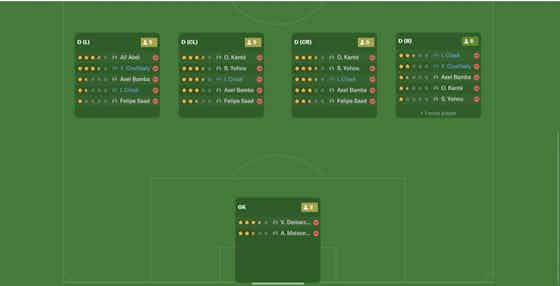
On the experienced side, former Les Bleus international Jérémy Ménez was by far and away my most high-profile player, followed by Burkina Faso legend Jonathan Pitroipa. Seasoned Ligue 2 winger Lalaïna Nomenjanahary, experienced centre-back Ousmane Kanté and club legend Vincent Demarconnay in goal were to make up the rest of my experienced spine. On the other hand, promising prospects Axel Bamba (centre-back), Anthony Maisonnial (goalkeeper) and loanees including the highly talented midfielder Vincent Koziello, struggling at FC Köln, and Amiens forward Cheick Timité, made up the younger stars.
The biggest talent by far was Lamine Diaby-Fadiga. Sacked by Nice after stealing teammate Kasper Dolberg’s €70,000 watch, Paris had offered him a fresh start. It was clear to me that the 18 year-old had the potential to become a star player for the team, and certainly Ligue 1 quality. He may have had disciplinary issues in the past, but this was a new start, and I would help him realise his promise.
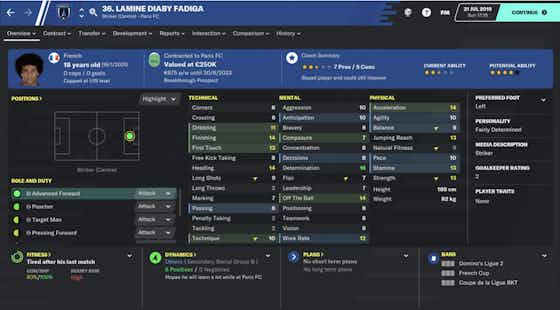
On arrival, I called a team meeting, to get to know the players and outline our expectations for the season. After assertively introducing myself, acting club captain Demarconnay welcomed me to the club, “we look forward to playing under your management.”
Though my hopes for the season were high (challenging for promotion), I wanted to remain realistic, at least with the players, as I know that being overambitious or unrealistic can often lead to unrest in the squad. My subsequent comments that we should be aiming for the top half were echoed by Demarconnay, with the squad reacting extremely positively overall.
Due to his experience, leadership, and influence in the squad, I decided there and then that Demarconnay would be my captain for the season, with experienced defender Ousmane Kanté as my vice-captain, for the same reasons.

After the meeting I decided to have a chat with Diaby-Fadiga. I could sense a certain anxiousness and reluctance, that he was still shaken by what had happened at Nice, and still coming to terms with being jettisoned by the club.
“You need to re-think your conduct if you want to make it here,” I started. “I’m not going to tolerate anything like that under my management. Please don’t force us to undertake any drastic action, we want you to succeed here.”
He nodded solemnly, but looked to shrink into himself. I continued, “Behave yourself, and focus on your football. Do that, and you’ll thrive; I’m counting on you this season.” His body language immediately improved as he raised his head, a hungry glint in his eye.
I also made a point of chatting to Jérémy Ménez and forward Romain Armand, asking the two of them to keep an eye out for him and help mentor him in training.
Next on my schedule was my first press conference with the club. Asked what my initial thoughts were on joining, I responded that I was excited, that there was a lot of work to do but that I was proud to be given the opportunity, while also underlining the enormous potential in the club. As a young coach, naturally I faced some scepticism from the media, so I was honest about how I planned to garner respect: “By winning games.”
Setting up the team
The mood around the club seemed positive. The players were in good spirits, with loanee Cheick Timité and full-back Ali Abdi winning their first caps for the Ivory Coast and Tunisia respectively. With a hectic pre-season calendar ahead, I thought it best to take a more detailed look at the players at my disposal, and work out a system which would best suit the team.
Ligue 2 is a physical division, with teams often playing a more direct, combative style of football. Not only did I want to try and encourage a more dynamic style of play, but also it seemed somewhat necessary: our squad was below average in terms of height and weight for the league, and so dominating teams physically did not seem like the way forward. To win games, we needed to keep the ball on the ground.
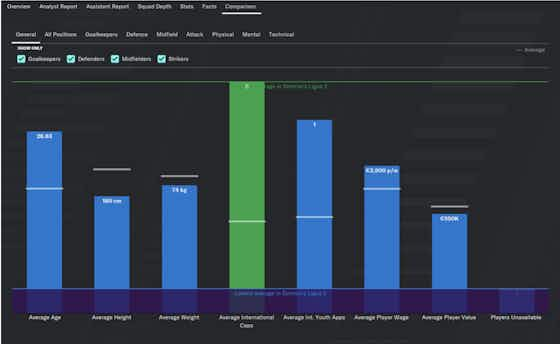
With our more talented players being more technical (the likes of Koziello, Ménez, and Pitroipa), I decided that a more positive style was needed. We would enjoy keeping hold of the ball, but potentially suffer without it. As a result, I wanted to implement a high-intensity pressing game, where we would engage the opposition urgently to try to win the ball back, playing with higher attacking and defensive lines. In possession, I wanted us to play at a higher tempo, playing out of defence and working the ball into the box through using the available spaces we created.
Settling on a formation wasn’t easy. While we had an abundance of forwards and midfielders, in defence we were relatively thin on the ground, with loanee Ibrahim Cissé our only first-team quality option at right-back. I then decided that, due to his promise, excellent finishing and physical attributes that I wanted Diaby-Fadiga to lead the line. Meanwhile, Jérémy Ménez’s dribbling, passing and flair made him an ideal option in attacking midfield at no.10 in support. I wanted the team to be built around the relationship between these two players, aided both in attack and in pressing by the energetic and experienced Pitroipa and Nomenjanahary. I thus settled on a 4-2-3-1 system.

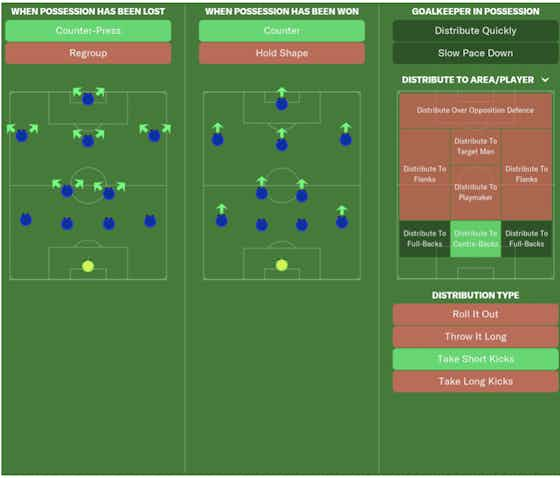
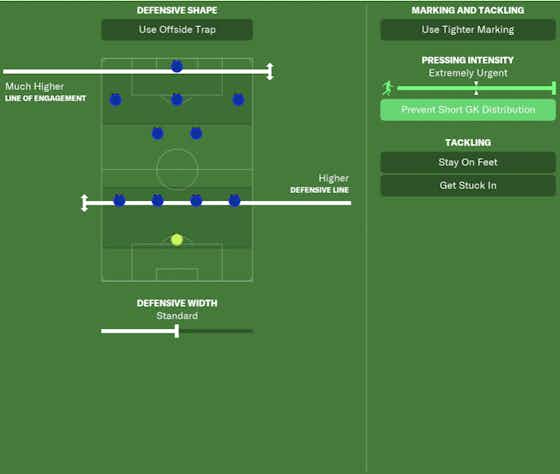
Pitroipa’s dribbling, acceleration, flair, and eye for goal made him an ideal option to play as an inside forward, pushing further up the pitch, cutting inside and wreaking havoc, either through passing, crossing or shooting himself. My other winger, ideally Nomenjanahary (the best option quality-wise), would play as a more conventional winger, using his pace and technical proficiency to beat players attack the byline. From there, he can provide crosses into the box, notably for the 6 ft 2 Diaby-Fadiga, playing a more advanced role himself.

In central midfield, I would need two players whose respective skillsets were complimentary. Koziello, the most talented player in the side, seemed well-suited to a number of midfield roles, especially as a deep-lying playmaker. I however wanted to deploy him as a box-to-box midfielder, due to his tireless work-rate, solid passing ability and technical skills. As a more defensive foil, fellow Frenchman Cyril Mandouki seemed the best option as a ball winning midfielder due to his impressive anticipation, strength, tackling and concentration, with his higher stamina vital to the intense system I wanted to implement.
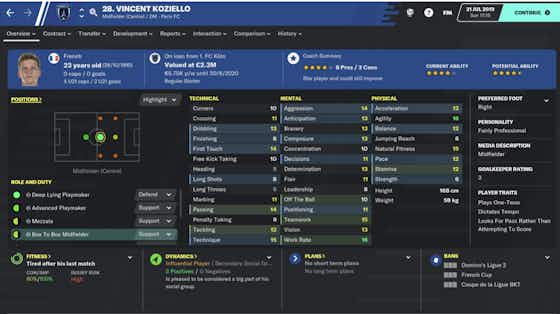
In defence, Burkina Faso international Yacouba Coulibaly’s speed, work-rate and overall quality meant that he was a clear first-choice on the left as a more attack-minded full-back, with Angers loanee Cissé providing my only viable option on the right. Vice captain Ousmane Kanté would be a mainstay in central defence, while I hoped young Ivorian Axel Bamba could challenge experienced compatriot Samuel Yohou for the final starting birth due to his high potential.
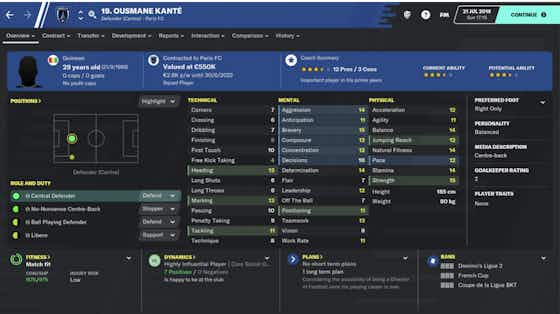
Obviously, the system would need to be tested and altered, and form and injuries would have their say in personnel selection; Nomenjanahary, for instance, was set to miss the entire pre-season due to holiday. That being said, before a single ball was kicked, I knew what I wanted.

Pre-season
Our schedule for pre-season was a compact and varied one: starting at the Stade Charléty against Lille on the 29th of June, followed by Bayer Leverkusen (H), Peterborough (A) and Genk (H) all within 11 days. We would then play Vincent Demarconnay’s testimonial against Le Mans, the club where his career began, before a trip to Dutch third division outfit TEC VV, and finally face Brentford at home a week before the league campaign kicked-off away at Troyes. We had just over a month to get the players match fit.
After some minor setbacks (including winger Julien López spraining his ankle ligaments in training), it was time for our first match against Lille. Well aware of their quality, I opted for a slightly more defensive variation of our system, sitting slightly deeper and encouraging the players to be slightly more disciplined, a decision that paid dividends.
With Nomenjanahary absent, I opted to play Lorient loanee Mohamed Mara at left-wing, with his dribbling, pace and work-rate making him our best replacement. Given his experience and the potency of the opposition, I decided to start Yohou over Bamba in central defence. Lille, on their part, fielded a strong side, with Timothy Weah flanked by Loïc Rémy and Luiz Araújo, supported by Yusuf Yazici in attacking midfield.
Walking out onto the touchline, I shook hands with Christophe Galtier, fresh off the back of his phenomenal season with Les Dogues. The Frenchman however seemed to look straight through me, and seemed almost dismissive. In that moment, I thought to myself: “I’ll show you a real 4-2-3-1.”
Despite my efforts to encourage the players to fight for their places, it was Lille who started on the front foot, putting together some nice passing moves before breaking through our defensive line and releasing Timothy Weah, Demarconnay saving from a poor shot.
However, we began to grow into the game, and a series of near-misses finally resulted in the opening goal; a free-kick just inside the Lille half found Mandouki just outside the 18-yard box, who lobbed the ball out to the right for right-back Cissé, with the Angers loanee providing a floated cross which was met and deftly headed in by Diaby-Fadiga at the far post. 16 minutes in, it was 1-0.
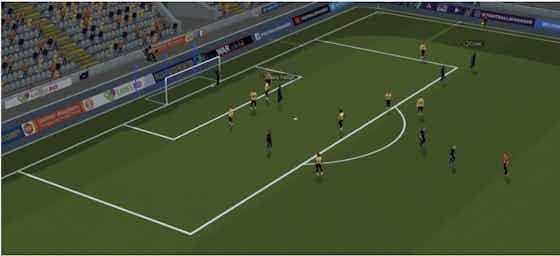
The tempo subsequently slowed, as we frustrated Lille’s attempts to push for an equaliser, until the 31st minute. During a Lille attack, Koziello pinched the ball from Yazici and made a darting run into their half, bounding towards the area, before threading a through ball to Mara on the left, who cut inside into the box. The winger laid the ball off for left-back Coulibaly, whose furious strike cannoned off the post. Pitroipa, however, was there to tap in the rebound.
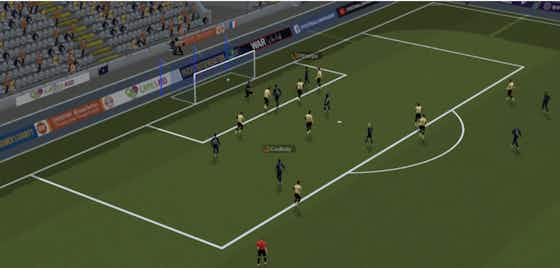
Our perfect first half performance continued into the second, as we continued to frustrate the visitors. Demarconnay made a couple of decent saves from set pieces, as both sides made numerous changes. Despite a few problems caused by Lille youngster Eddy Ouattara, we were in control. I made yet more changes, leaving us with a largely unrecognisable 11 from the side that started the match, and instructed us to sit deeper and soak up pressure. Lille did manage to pull a goal back in the 92nd minute, with Canadian international Charles Andreas Brym volleying in unchallenged from a corner; but the win was ours, a terrific first match, with the players all looking in great spirits at full time.
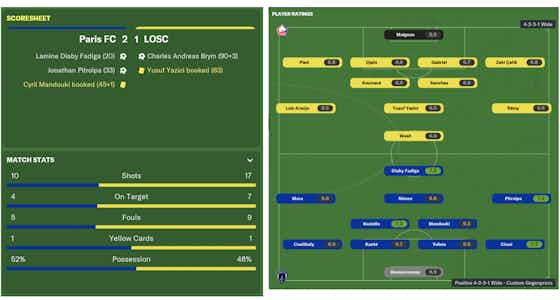
After a quiet few days in training, it was time for what would be the greatest challenge of pre-season, a clash against Bundesliga powerhouse Bayer Leverkusen.
Given the pace of the opposition’s attacking players and Peter Bosz’s penchant for explosive attacking football, I decided it was time to work on a secondary tactic for playing against such teams: a more reactive, counter-attacking 4-2-3-1 where we would sit further back, still pressing hard when losing the ball but generally laying off the opposition and striking swiftly and fluidly when we had the chance, something the players seemed to buy into in training.
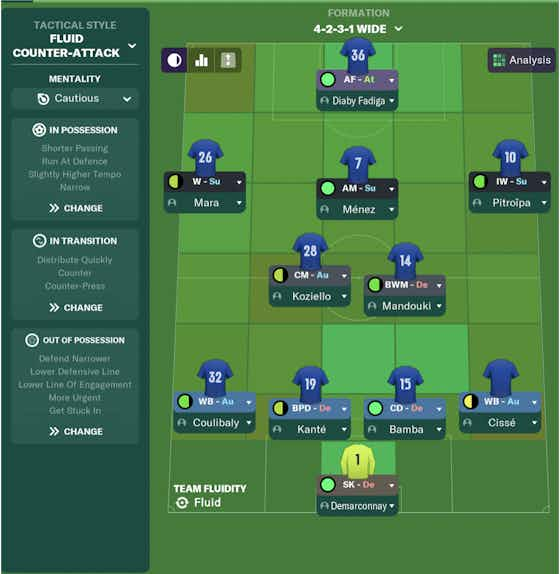
The day before the match, the board called me in to discuss our objectives for the season in the domestic cup competitions. In the Coupe de la Ligue we had to reach the second round, while the tenth was the target in the Coupe de France. “Child’s play,” I thought. Or so I hoped.
The following evening came around quickly, and it was time for the big match. Morale was high after beating Lille, and the last thing I wanted was for that spirit to shatter with a heavy defeat. Opting to make several changes for match fitness, including Florian Martin at ten over Ménez and Felipe Saad at centre-back in place of Kanté and Bamba over Yohou, we were raring to go. I could immediately tell this was a different kind of challenge.
Bosz fielded an immensely talented side, featuring the likes of Kai Havertz, promising winner Moussa Diaby, midfielder Charles Aranguiz and striker Kevin Volland. The visitors were electric from kick-off, and we were very much on the back foot, but our new system looked to be doing the trick, restricting them to half chances. Felipe Saad worryingly picked up a knock, and had to make way for Kanté, but a solid defensive shift saw us enter the dressing room at half time with the score at 0-0. We had however failed to register a single shot.
I told the players I was pleased with their efforts, wanted more of the same, and that if we could find an opportunity to break, we could still get the win. I realised the error of my approach when, eight minutes into the second half, Moussa Diaby volleyed in from the edge of the area. 1-0 Leverkusen.
At this point, I made a series of changes, including midfielder Jason Kikonda on for Cyril Mandouki, and switched us into our more positive, pressing game. Despite still taking a pounding defensively, we were solid, and finally got a shot away in the 65th minute.
I made a flurry of late changes in the 80th minute, and screamed on the touchline for the players to start pushing further forward, but the game was to end with the Leverkusen win. Thoroughly outgunned, we had still shown a lot of promise defensively against a terrific team, and that was a positive. Even if the bus had been well and truly parked.

For our next few matches, I opted to stick with our attacking game plan. A frustrating 0-0 against Peterborough was followed by a highly satisfying 2-0 win over Genk, with young goalkeeper Maissonnial putting in an impressive showing, and goals from Pitroipa and Senegalese forward Adama Sarr.
After a great week of training, I finally felt like I was getting to know the players and that the squad was really bonding going into the season. This culminated in what was a touching moment for the club: Vincent Demarconnay’s testimonial.
Having been at the club since 2008, and become one of the best goalkeepers in the division, this was a special moment for Demarconnay, getting to play against the club where he started his career, Le Mans. It was also a chance for us to face off against Ligue 2 opposition for the first time. I again opted for our positive 4-2-3-1, with Ménez and Diaby-Fadiga returning to the side, and Jason Kikonda partnering Koziello in midfield.
Emotions were riding high at kick-off, and were clearly getting the best of “Vinnie” (yes, we are already on a nickname basis), who made a couple of questionable clearances in the opening 15 minutes, meaning we were lucky not to concede!
We did however grow into the game, going on to dominate the rest of the match. Le Mans, in rather unsporting fashion, seemed to treat the game like a league clash, playing with brute force, being excessively physical and fouling us left right and centre. At one point in the second half, I stormed over to Réginald Ray in the opposing dugout: “What are you playing at? This is a testimonial! Tell your lads to lay off!” He seemed however to see no wrong in the way his side were playing.
Despite our domination, Demarconnay did have his moment, flying through the air to deflect a well-timed strike from Yanis Merdji late on to keep things 0-0. The game ended goalless, but the full-time whistle came as a relief. Escaping without injury had been a minor miracle.

With two friendlies remaining, it was time to decide squad numbers. I decided to keep most numbers as they were, save for Jérémy Ménez, who came to see me in my office after training to ask if he could wear the number 7 shirt. “I’m expecting 30 goals + assists now,” I thought.
Our penultimate pre-season match was against Dutch Tweede Divisie side TEC VV. Saad and López were now fit, but I opted for a largely full-strength side, save for Florian Martin, lacking match sharpness, starting over Ménez in attacking midfield.
What followed was our most complete performance of pre-season, as we completely outclassed the hosts. After Diaby-Fadiga was bundled over in the box in the 7th minute, leading to our opening goal (a Florian Martin penalty), we never looked back, hitting them for six. Diaby-Fadiga, in particular, was electric: a nightmare from set-pieces, scoring two headers before completing his hat-trick late on with a low-driven strike across goal. Taking him off for Sarr, I told him how delighted I was, “That’s exactly what I’m looking for.”
Having made in 6-0 by the 64th minute, the TEC fans seemed to realise any chance of a comeback was off, and left in their droves. Well, all 400 of them.
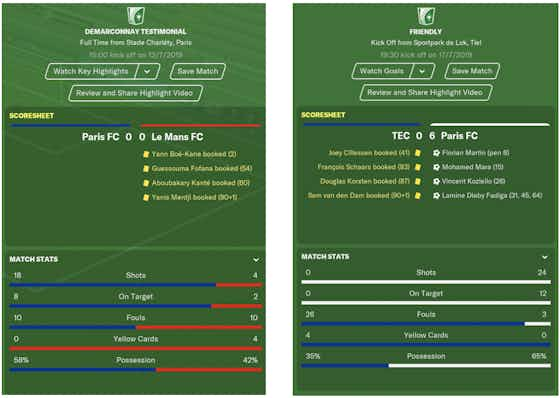
After giving the players the day off following their excellent showing, with Ménez in particular looking happy to get some rest, I went to discuss competition bonuses with the board. Knowing that we had as good a chance as most to fight for at least the playoff places, I implored them to offer the players a higher bonus for the league as an extra incentive, countering that with a lower bonus for cup performances. After some beard and head scratching, they agreed.
The Coupe de la Ligue draw for the first and second rounds were also out that day, and we were handed a more favourable chance than most: facing National side Béziers, we would play another third-tier side, Gazélec FC Ajaccio or even bitter rivals Red Star if we advanced. The prospect of a derby? Incentive enough in itself.

On the 20th of July, a week to the day before starting our league campaign away at Troyes, we faced Brentford at the Charléty in our final friendly. I now had everyone at my disposal, save for the ever-holidaying Nomenjanahary (set to return on the 1st of August), who was clearly enjoying sunning himself elsewhere. Despite my WhatsApp messages not sending, Demarconnay had assured me that the winger was on a retreat, and that he would show up as expected on the 1st. “If he doesn’t, he’ll be on kit duty for the U19s,” I thought to myself. Given that everyone else was fit, I went into the match with what I regarded as our first-choice XI, with Mara starting at left-wing. Though Brentford were superior opposition, I wanted to test out our more positive tactics. I was also excited to test the boys against some of Ligue 2’s recent successful exports, namely Saïd Benrahma and Bryan Mbeumo.
Sadly, the former wasn’t playing in a rather youthful Brentford side, but Mbeumo did start on the right and was unsurprisingly the main creative outlet. After geeing the players up to fight to retain their places in the side for next weekend, we came roaring out of the blocks, with Axel Bamba heading in from a Koziello free-kick to make it 1-0 inside 2 minutes.
For much of the match, we were by far the better side, with Diaby-Fadiga scuffing a few decent chances. 33 minutes in and we made it two, with Jéremy Ménez cooly converting a penalty won for handball. Our system was causing Brentford all kinds of problems, and Brentford coach Thomas Frank cut an anxious figure on the touchline.
Mbeumo was unsurprisingly the player causing us the most problems, working the ball into dangerous positions, causing Ibrahim Cissé a fair amount of bother after switching to the left flank. It looked at one stage like he was going to drag the bees single-handedly back into the match.
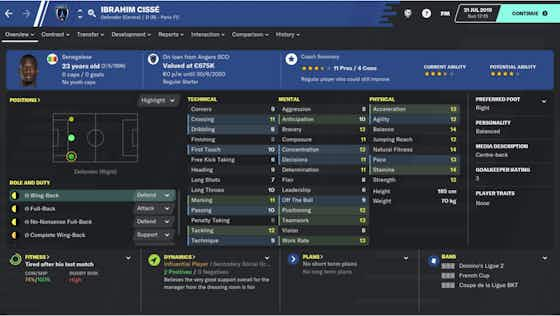
However, as we’d seen so often in pre-season, Koziello’s exquisite set pieces gave us gilt-edged opportunities, and a free-kick from the right found the young Axel Bamba again who scored his second header of the match, making it 3-0.
Ecstatic with the players at half-time, I started to switch things up in the second half, giving playing time to most of the other subs, including a now-fit Julien López, who came on for Mara. Though Mbeumo had his chances, Brentford never truly looked like scoring, and the final 45 minutes were goalless.
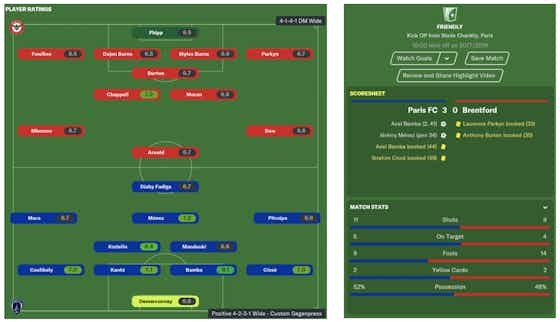
The win was the perfect end to what had been a thoroughly successful pre-season. Diaby-Fadiga, Koziello, Ménez, Pitroipa and our defence had been on terrific form. We had beaten the likes of Lille, Genk and Brentford, thrashed Dutch minnows and lost one match narrowly to a side playing in the Champions’ League. Our system looked solid, the players seemed motivated and with 13 scored and just two conceded, I truly felt we were ready for the challenge ahead. We were ready to fight for promotion.































































